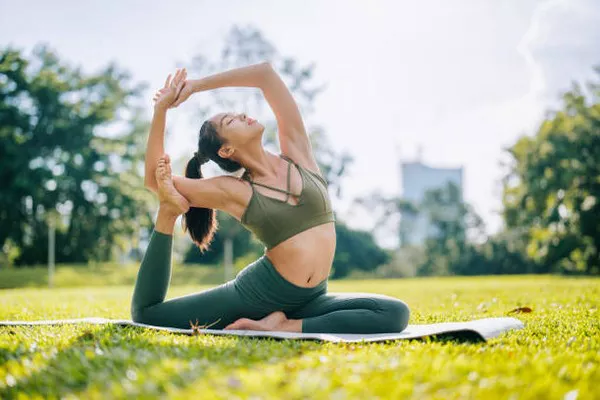Vinyasa Yoga is a dynamic and flowing form of yoga that synchronizes breath with movement. This style of yoga is known for its smooth transitions between poses and its ability to create a meditative experience through continuous movement. Vinyasa Yoga offers a variety of poses that can help improve strength, flexibility, and balance while calming the mind.
The Importance of Breath in Vinyasa Yoga
In Vinyasa Yoga, each movement is linked to an inhale or an exhale, creating a seamless flow. This connection to the breath helps practitioners stay present and focused, enhancing the overall yoga experience. The breath serves as an anchor, guiding the transitions from one pose to the next.
Sun Salutations: The Foundation of Vinyasa Flow
Surya Namaskar A
Surya Namaskar A, or Sun Salutation A, is a fundamental sequence in Vinyasa Yoga. It includes:
Mountain Pose (Tadasana): Stand tall with feet together, arms at sides.
Upward Salute (Urdhva Hastasana): Inhale, raise arms overhead, and look up.
Forward Fold (Uttanasana): Exhale, fold forward, and touch the ground.
Halfway Lift (Ardha Uttanasana): Inhale, lift halfway, and lengthen the spine.
Chaturanga Dandasana: Exhale, step or jump back into a low plank.
Upward-Facing Dog (Urdhva Mukha Svanasana): Inhale, lift chest, and look up.
Downward-Facing Dog (Adho Mukha Svanasana): Exhale, lift hips, and form an inverted V.
Surya Namaskar B
Sun Salutation B adds a few more poses to the sequence:
Chair Pose (Utkatasana): Bend knees, and sit back as if in a chair.
Warrior I (Virabhadrasana I): Step one foot back, and raise arms overhead.
Warrior II (Virabhadrasana II): Open hips and arms to the sides.
Standing Poses: Building Strength and Stability
Warrior Poses
Warrior I (Virabhadrasana I): Strengthens legs and core while opening the chest.
Warrior II (Virabhadrasana II): Enhances balance and stability.
Warrior III (Virabhadrasana III): Improves balance and core strength.
Triangle Pose (Trikonasana)
Triangle Pose (Trikonasana): Stretches the sides of the torso and strengthens the legs.
Extended Side Angle Pose (Utthita Parsvakonasana)
Extended Side Angle Pose (Utthita Parsvakonasana): Opens the hips and stretches the side body.
Balancing Poses: Enhancing Focus and Coordination
Tree Pose (Vrksasana)
Tree Pose (Vrksasana): Improves balance and concentration.
Eagle Pose (Garudasana)
Eagle Pose (Garudasana): Strengthens legs and improves focus.
Half Moon Pose (Ardha Chandrasana)
Half Moon Pose (Ardha Chandrasana): Enhances balance and opens the hips.
Backbends: Opening the Heart and Spine
Cobra Pose (Bhujangasana)
Cobra Pose (Bhujangasana): Strengthens the back muscles and opens the chest.
Upward-Facing Dog (Urdhva Mukha Svanasana)
Upward-Facing Dog (Urdhva Mukha Svanasana): Lifts the chest and stretches the front of the body.
Bow Pose (Dhanurasana)
Bow Pose (Dhanurasana): Stretches the entire front body and strengthens the back.
See Also: Is Vinyasa Flow Yoga For Beginners
Seated Poses: Enhancing Flexibility and Relaxation
Seated Forward Bend (Paschimottanasana)
Seated Forward Bend (Paschimottanasana): Stretches the hamstrings and calms the mind.
Bound Angle Pose (Baddha Konasana)
Bound Angle Pose (Baddha Konasana): Opens the hips and stretches the inner thighs.
Seated Twist (Ardha Matsyendrasana)
Seated Twist (Ardha Matsyendrasana): Improves spinal flexibility and digestion.
Inversions: Reversing the Flow
Shoulder Stand (Sarvangasana)
Shoulder Stand (Sarvangasana): Improves circulation and calms the mind.
Headstand (Sirsasana)
Headstand (Sirsasana): Enhances balance and strengthens the core.
Legs-Up-the-Wall Pose (Viparita Karani)
Legs-Up-the-Wall Pose (Viparita Karani): Relaxes the body and soothes the nervous system.
Cool Down: Preparing for Relaxation
Bridge Pose (Setu Bandhasana)
Bridge Pose (Setu Bandhasana): Opens the chest and strengthens the back.
Supine Twist (Supta Matsyendrasana)
Supine Twist (Supta Matsyendrasana): Releases tension in the spine and promotes relaxation.
Happy Baby Pose (Ananda Balasana)
Happy Baby Pose (Ananda Balasana): Stretches the inner thighs and groin.
Savasana: The Final Relaxation
Corpse Pose (Savasana)
Corpse Pose (Savasana): Allows the body and mind to rest and integrate the practice.
Conclusion: Embracing the Flow of Vinyasa Yoga
Vinyasa Yoga offers a diverse range of poses that cater to all levels of practitioners. The continuous flow, synchronized with the breath, creates a dynamic and meditative practice that enhances both physical and mental well-being. By incorporating these poses into your practice, you can experience the transformative power of Vinyasa Yoga.


